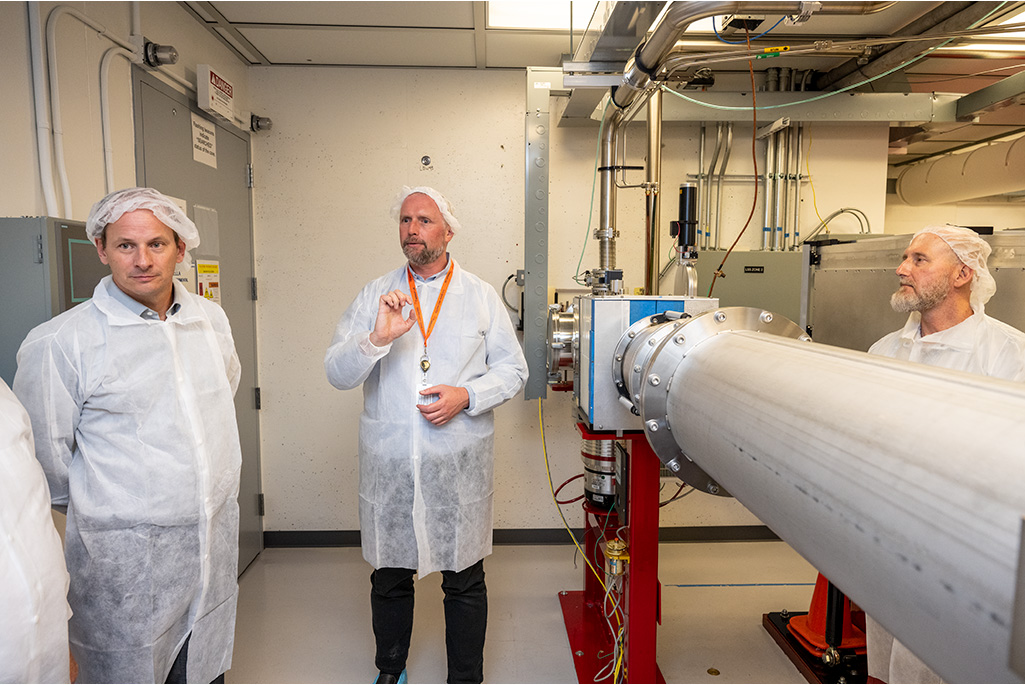The workshop, jointly sponsored by the U.S. Department of Energy, the National Science Foundation, and the Department of Defense, brought together experts from national and international universities, laboratories, and industry to identify crucial research directions to advance laser technologies in various fields. Cameron Geddes, the ATAP division director, co-chaired the workshop, held from August 15-17, 2023, in Rockville, Maryland, and was joined by others from the Lab, including Tong Zhou, Stepan Bulanov, and Qiang Du from ATAP, Junko Yano from the Molecular Biophysics & Integrated Bioimaging Division, and Vassilia Zorba from Energy Storage & Distributed Resources Division.
The workshop discussed technology areas, including high peak and average power sources, extensions to new wavelength regimes and light sources, and enabling technologies. The participants identified four priority research directions (PRDs) for advancing laser technologies:
PRD 1: Revolutionize Laser Power, Energy, and Precision Control
Key Questions: How might ultra-intense laser performance be extended to create and probe extreme conditions that represent the frontiers of science needs in the next decade? What laser architectures enable high-repetition-rate operations? How could ultrahigh-peak-power lasers also be scaled to extreme repetition rates?
PRD 2: Transform Mid-IR Sources for Science from THz to X-Rays
Key Questions: Can we create the new laser technologies needed to meet the significant demands for high average and peak power mid-infrared (mid-IR) science, and for driving secondary sources with extreme spectral coverage? How do we overcome the current limitations in mid-IR laser intensity to take full advantage of wavelength-dependent scalings? What are the ideal wavelengths, platforms, and architectures for nonlinear conversion to generate transformative sources in hard-to-access spectral ranges?
PRD 3: Revolutionize Approaches to Frequency Conversion and Field Control
Key Questions: Can we advance laser light manipulation with bandwidth efficiently extended from the deep ultraviolet to THz ranges, employing all ranges simultaneously and with exquisite control of field structure? Can we synchronize these sources to secondary radiation and particle beams? Is it possible to simultaneously greatly reduce the complexity of laser systems, making them accessible, affordable, stable, and robust?
PRD 4: Reinvent Materials and Optics for Intense Laser Science
Key Questions: What are the most significant improvements to materials and optics needed for next-generation ultrahigh intensity and high-average-power laser technologies? What can be discovered to expand the spectral range of ultrafast lasers toward the mid-IR and ultraviolet? What new concepts can be exploited to innovate materials and optics for intense laser science?
ATAP researchers and collaborators are advancing the state of the art of laser technology toward many of these goals. They are pioneering laser architectures to enable high-repetition-rate operations of ultrahigh-peak-power lasers via coherent combination of fiber lasers. These hold the key to precision, high-performance plasma accelerators via the active feedback possible at kHz rates.
This novel fiber laser technology forms the basis of the Division’s initiative towards the kBELLA project. The kBELLA facility will provide the environment to establish next-generation plasma-based particle accelerators driven by revolutionary new fiber lasers. The increased average power generated by the fiber lasers will be transformed into high-average power ultrarelativistic electron beams on the GeV scale to drive novel applications in light sources, security, and medicine. In addition, the increased precision from active feedback will significantly increase the stability and tunability of these applications compared to today’s solutions built on legacy laser technology. kBELLA is a significant stepping stone to developing the precision and high average power laser capability that is scalable and needed for future particle accelerators and colliders.
Click here to read the workshop’s full report.
For more information on ATAP News articles, contact caw@lbl.gov.
